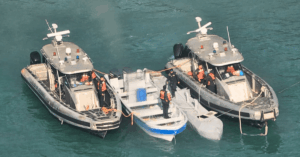Colombia Seizes First Unmanned Narco-Sub Equipped With Starlink Connection
The Colombian Navy announced the seizure of the country’s first unmanned narco-submarine equipped with a Starlink antenna on July 2, 2025. The vessel was found off Colombia’s Caribbean coast and is believed to be a test run for drug smuggling using remote-controlled technology.
This marks the first known discovery of an autonomous narco-submarine in South American waters. Officials confirmed that the vessel was not carrying any drugs at the time of the seizure in April, but it was designed to carry up to 1.5 tons of cocaine and travel a distance of about 800 miles.
According to the navy, the submarine belongs to the Gulf Clan, Colombia’s largest drug trafficking group.
The submarine had two antennas, one protected with fiberglass, connected to a Starlink satellite modem for communication. It was also equipped with two surveillance cameras: one for navigating the vessel and the other for monitoring its engine.
Naval officials said this unmanned semi-submersible was built in Colombia. It travels close to the water’s surface, making it hard to detect, with only the air inlets and antenna visible above the waterline. However, this design is not a true submarine, as it cannot fully submerge.
Admiral Juan Ricardo Rozo, Chief of the Colombian Navy, stated during a press event that traffickers are moving toward more advanced and unmanned smuggling systems. These systems are harder to detect by radar and make it easier for criminal groups to operate with partial autonomy. He added that the use of such technology shows a shift in drug trafficking strategies toward more innovative and adaptive methods.
The discovery was part of the Orion Multinational Strategy, an international operation led by Colombia to combat drug trafficking and related crimes. In the first half of 2025, Colombia and its global partners reported seizing 2,326 tons of narcotics, including heroin, cocaine, marijuana, methamphetamines, and hashish, with support from 62 countries.
Experts say removing the crew from these vessels reduces the risk of traffickers being captured and revealing information. It also solves the problem of finding people willing to operate dangerous, makeshift vessels that are often described as floating “coffins.”
Henry Shuldiner, an investigator with the U.S.-based think tank InSight Crime, said that unmanned drug subs are not only harder to trace back to criminal leaders, but also eliminate the chance of crew members cooperating with law enforcement if caught.
Juana Cabezas, a researcher from Colombia’s Institute for Development and Peace Studies, said that Mexican drug cartels working in Colombia have been developing unmanned submarines since 2017. She added that these cartels hired engineers and tech experts to design such systems.
Open-source naval experts stated that although these uncrewed vessels are difficult to detect, they are not necessarily stealthier than manned ones. However, the lack of onboard personnel reduces risk for smugglers. The downside is that if the engine fails, there is no one onboard to fix it, a risk the traffickers seem willing to take.
The use of Starlink, the satellite internet service by SpaceX, plays a key role in enabling remote communication with the vessel. Experts believe Starlink’s two-way data capability could be essential for future unmanned smuggling missions.
This isn’t the first time Starlink has been linked to drug trafficking. In November 2024, Indian authorities intercepted a remote-controlled vessel using Starlink near the Andaman and Nicobar Islands. It was carrying meth worth $4.25 billion.
Other unmanned vessels have also been detected in the Mediterranean, often used for short coastal trips between countries like Albania, Italy, Morocco, and Spain.
Narco-submarines have been used by Colombian cartels for decades, mostly for transporting cocaine north to Central America or Mexico. But in recent years, these vessels have made long-distance journeys across the Atlantic and Pacific Oceans.
In one major case in November 2024, a semi-submersible loaded with five tons of Colombian cocaine was seized en route to Australia.
According to the UN drug agency, cocaine production, seizures, and use all hit record highs in 2023. Colombia, the world’s largest cocaine producer, has seen a sharp rise in production due to increased global demand.
Colombian law punishes the use, construction, marketing, possession, and transport of semi-submersibles with sentences of up to 14 years in prison.
Security experts warn that unmanned systems like these, while offering operational advantages, also pose serious risks. They fear that the technology could fall into the hands of terrorist groups, making it harder to detect threats underwater than in the air or on the surface.
Some experts now recommend deploying hydrophone-based underwater detection systems around key ports and naval bases to counter this new type of threat.
References: france24, navalnews

